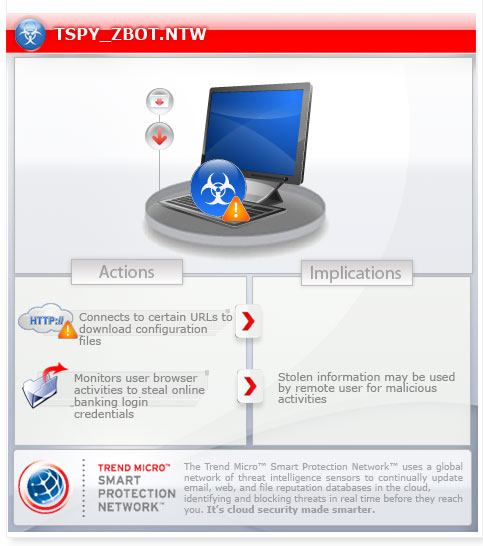TSPY_ZBOT.NTW
Windows 2000, Windows XP, Windows Server 2003


Threat Type: Spyware
Destructiveness: No
Encrypted: Yes
In the wild: Yes
OVERVIEW
Downloaded from the Internet, Dropped by other malware
This malware is reported to be involved with a malicious campaign concerning the 2012 US Presidential Election. Users affected by this malware may find their online banking credentials stolen.
To get a one-glance comprehensive view of the behavior of this Spyware, refer to the Threat Diagram shown below.

This spyware arrives on a system as a file dropped by other malware or as a file downloaded unknowingly by users when visiting malicious sites.
It is injected into all running processes to remain memory resident.
It modifies the Internet Explorer Zone Settings.
As of this writing, the said sites are inaccessible.
It deletes the initially executed copy of itself.
TECHNICAL DETAILS
330,240 bytes
EXE
Yes
10 Oct 2012
Downloads files, Steals information
Arrival Details
This spyware arrives on a system as a file dropped by other malware or as a file downloaded unknowingly by users when visiting malicious sites.
Installation
This spyware drops the following copies of itself into the affected system:
- %User Profile%\Application Data\{random1}\{random}.exe
(Note: %User Profile% is the current user's profile folder, which is usually C:\Documents and Settings\{user name} on Windows 2000, XP, and Server 2003, or C:\Users\{user name} on Windows Vista and 7.)
It drops the following files:
- %User Profile%\Application Data\Microsoft\Address Book\winxp.wab
(Note: %User Profile% is the current user's profile folder, which is usually C:\Documents and Settings\{user name} on Windows 2000, XP, and Server 2003, or C:\Users\{user name} on Windows Vista and 7.)
It creates the following folders:
- %User Profile%\Application Data\{random1}
- %User Profile%\Application Data\Microsoft\Address Book
(Note: %User Profile% is the current user's profile folder, which is usually C:\Documents and Settings\{user name} on Windows 2000, XP, and Server 2003, or C:\Users\{user name} on Windows Vista and 7.)
It is injected into all running processes to remain memory resident.
Autostart Technique
This spyware adds the following registry entries to enable its automatic execution at every system startup:
HKEY_CURRENT_USER\Software\Microsoft\
Windows\CurrentVersion\Run
{random CLSID} = "%User Profile%\Application Data\{random1}\{random}.exe"
Other System Modifications
This spyware adds the following registry keys:
HKEY_CURRENT_USER\Software\Microsoft\
{random}
HKEY_CURRENT_USER\Software\Microsoft\
WAB
It creates the following registry entry(ies) to bypass Windows Firewall:
HKEY_LOCAL_MACHINE\SYSTEM\CurrentControlSet\
Services\SharedAccess\Parameters\
FirewallPolicy\StandardProfile\AuthorizedApplications\
List
%Windows%\explorer.exe = "%Windows%\explorer.exe:*:Enabled:Windows Explorer"
Web Browser Home Page and Search Page Modification
This spyware modifies the Internet Explorer Zone Settings.
Download Routine
This spyware connects to the following URL(s) to download its configuration file:
- http://{pseudorandom alpha characters}.biz
- http://{pseudorandom alpha characters}.org
- http://{pseudorandom alpha characters}.info
- http://{pseudorandom alpha characters}.net
- http://{pseudorandom alpha characters}.ru
- http://{pseudorandom alpha characters}.com
As of this writing, the said sites are inaccessible.
Other Details
This spyware connects to the following URL(s) to check for an Internet connection:
- http://www.google.com/
- http://www.bing.com/
It deletes the initially executed copy of itself
NOTES:
The URL where it connects to is randomly generated using a randomizing function, which is computed based on the system's current date. The download file is the configuration file that contains the list of sites to be monitored.
The configuration file may contain URLs where it downloads an updated copy of itself and where it sends its gathered information. It may also contain URLs of its target online banking and finance-related sites from where it steals the information.
SOLUTION
9.200
9.454.02
10 Oct 2012
9.455.00
12 Oct 2012
Step 1
Before doing any scans, Windows XP, Windows Vista, and Windows 7 users must disable System Restore to allow full scanning of their computers.
Step 2
Restart in Safe Mode
Step 3
Delete this registry key
Important: Editing the Windows Registry incorrectly can lead to irreversible system malfunction. Please do this step only if you know how or you can ask assistance from your system administrator. Else, check this Microsoft article first before modifying your computer's registry.
- In HKEY_CURRENT_USER\Software\Microsoft
- WAB
- WAB
Step 4
Delete this registry value
Important: Editing the Windows Registry incorrectly can lead to irreversible system malfunction. Please do this step only if you know how or you can ask assistance from your system administrator. Else, check this Microsoft article first before modifying your computer's registry.
- In HKEY_CURRENT_USER\Software\Microsoft\Windows\CurrentVersion\Run
- {Random CLSID} = "%User Profile%\Application Data\{random1}.exe"
- {Random CLSID} = "%User Profile%\Application Data\{random1}.exe"
- In HKEY_LOCAL_MACHINE\SYSTEM\CurrentControlSet\Services\SharedAccess\Parameters\FirewallPolicy\StandardProfile\AuthorizedApplications\List
- %Windows%\explorer.exe = "%Windows%\explorer.exe:*:Enabled:Windows Explorer"
- %Windows%\explorer.exe = "%Windows%\explorer.exe:*:Enabled:Windows Explorer"
Step 5
Search and delete these folders
- %User Profile%\Application Data\{random1}
- %User Profile%\Application Data\Microsoft\Address Book
Step 6
Reset Internet security settings
Step 7
Restart in normal mode and scan your computer with your Trend Micro product for files detected as TSPY_ZBOT.NTW. If the detected files have already been cleaned, deleted, or quarantined by your Trend Micro product, no further step is required. You may opt to simply delete the quarantined files. Please check this Knowledge Base page for more information.
NOTES:
The created registry key HKEY_CURRENT_USER\Software\Microsoft\{random} cannot be identified by the user since there are no reference values in the created key. The only way it can be identified is by comparing the present keys with a backup if the users have one. Note that the key need not to be deleted since it won't cause the user system any harm.
Did this description help? Tell us how we did.

